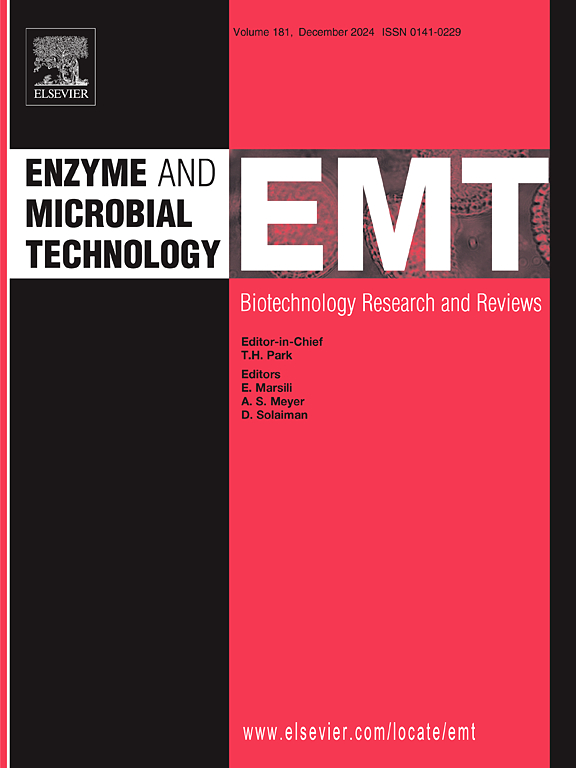Isolation, expression and characterization of a novel thermo-acid/alkali-stable GH10 xylanase BsXynA from Bacillus safensis L7 and its potential for xylooligosaccharide production and animal feed saccharification
IF 3.7
3区 生物学
Q2 BIOTECHNOLOGY & APPLIED MICROBIOLOGY
引用次数: 0
Abstract
Xylanases have wide applications in agro-industrial processes. This study reports the discovery and characterization of a novel thermo-acid/alkali-stable GH10 xylanase (BsXynA) from Bacillus safensis L7. The xylanase gene (BsxynA) was cloned and expressed in Escherichia coli BL21 (DE3), yielding a protein of approximately 64 kDa. BsXynA exhibited optimal activity (17.33 U/mg) on beechwood xylan at pH 6.0 and 60°C. Moreover, BsXynA exhibited remarkable thermo-acid/alkali stability, retaining over 60 % activity at pH 5.0–8.0 after 60 min at 60°C and over 80 % activity after 14 days at 4°C within pH 6.0–9.0. Additionally, the enzyme tolerated 50°C and various chemicals, with a half-life of over 16 days. It was activated by K⁺, Na⁺, Ca²⁺, Ba²⁺, and Mg²⁺ ions but inhibited by Zn²⁺, Cu²⁺, and SDS. BsXynA hydrolyzed various xylans but not glucose-based polysaccharides. Km, Vmax, kcat, and kcat/Km for beechwood xylan hydrolysis were found to be 6.61 mg/mL, 24.24 µmol·min−1·mg−1, 15.71 s−1, and 2.38 mL·s−1·mg−1 respectively. Thin-layer chromatography (TLC) analysis showed that BsXynA is an endo-type xylanase, which hydrolyzes beechwood xylan to produce mainly xylobiose (X2) and xylotetraose (X4), with no xylose detected. Furthermore, BsXynA improved animal feed saccharification, making it a promising biocatalyst for biotechnological applications.
一种新型热酸/碱稳定型GH10木聚糖酶BsXynA的分离、表达和鉴定及其在低聚木糖生产和动物饲料糖化中的应用前景
木聚糖酶在农工生产过程中有着广泛的应用。本研究报道了一种新的热酸/碱稳定木聚糖酶(BsXynA)的发现和鉴定。在大肠杆菌BL21 (DE3)中克隆并表达了木聚糖酶基因(bxyna),得到了一个约64 kDa的蛋白。在pH 6.0和60℃条件下,BsXynA对山毛榉木聚糖的活性为17.33 U/mg。此外,BsXynA表现出显著的热酸/碱稳定性,在pH 5.0-8.0下,在60°C下60 min后,活性保持在60% %以上,在pH 6.0-9.0下,在4°C下14 d后活性保持在80% %以上。此外,该酶耐受50°C和各种化学物质,半衰期超过16天。它被K +、Na +、Ca 2 +、Ba 2 +和Mg 2 +激活,但被Zn 2 +、Cu 2 +和SDS抑制。BsXynA能水解多种木聚糖,但不能水解葡萄糖基多糖。山毛榉木聚糖水解的Km、Vmax、kcat和kcat/Km分别为6.61 mg/mL、24.24µmol·min−1·mg−1、15.71 s−1和2.38 mL·s−1·mg−1。薄层色谱(TLC)分析表明,bxyna是一种内型木聚糖酶,主要水解山毛榉木聚糖生成木糖二糖(X2)和木糖四糖(X4),未检测到木糖。此外,BsXynA改善了动物饲料的糖化,使其成为一种有前景的生物技术应用的生物催化剂。
本文章由计算机程序翻译,如有差异,请以英文原文为准。
求助全文
约1分钟内获得全文
求助全文
来源期刊

Enzyme and Microbial Technology
生物-生物工程与应用微生物
CiteScore
7.60
自引率
5.90%
发文量
142
审稿时长
38 days
期刊介绍:
Enzyme and Microbial Technology is an international, peer-reviewed journal publishing original research and reviews, of biotechnological significance and novelty, on basic and applied aspects of the science and technology of processes involving the use of enzymes, micro-organisms, animal cells and plant cells.
We especially encourage submissions on:
Biocatalysis and the use of Directed Evolution in Synthetic Biology and Biotechnology
Biotechnological Production of New Bioactive Molecules, Biomaterials, Biopharmaceuticals, and Biofuels
New Imaging Techniques and Biosensors, especially as applicable to Healthcare and Systems Biology
New Biotechnological Approaches in Genomics, Proteomics and Metabolomics
Metabolic Engineering, Biomolecular Engineering and Nanobiotechnology
Manuscripts which report isolation, purification, immobilization or utilization of organisms or enzymes which are already well-described in the literature are not suitable for publication in EMT, unless their primary purpose is to report significant new findings or approaches which are of broad biotechnological importance. Similarly, manuscripts which report optimization studies on well-established processes are inappropriate. EMT does not accept papers dealing with mathematical modeling unless they report significant, new experimental data.
 求助内容:
求助内容: 应助结果提醒方式:
应助结果提醒方式:


